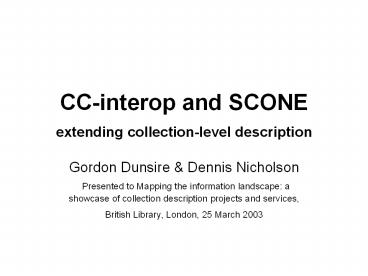CC-interop and SCONE extending collection-level description - PowerPoint PPT Presentation
Title:
CC-interop and SCONE extending collection-level description
Description:
Presented to Mapping the information landscape: a showcase of collection ... Functional granularity will proliferate CLDs for sub-collections ... – PowerPoint PPT presentation
Number of Views:14
Avg rating:3.0/5.0
Title: CC-interop and SCONE extending collection-level description
1
CC-interop and SCONE extending collection-level
description
- Gordon Dunsire Dennis Nicholson
- Presented to Mapping the information landscape
a showcase of collection description projects and
services, British Library, London, 25 March 2003
2
CC-interop project
- "COPAC/Clumps interoperability"
- Continuing technical cooperation
- Lead site London School of Economics and
Political Science - 2 work packages
- A Cross-searching COPAC and clumps
- B Enhance the role of clumps (in the JISC IE)
3
Work package B
- Using CAIRNS (CDLR) and RIDING clumps with SCONE
CLD service for - Investigating and specifying collection
description standards requirements ? - Enhancing the coverage of clumps ?
- Compiling cataloguing and indexing standards in
clumps - Landscaping of mini-clumps
4
CLD schemes compared
- Survey of clumps, collection description
services, and draft schemas - InforM25, JISC, MIMAS, Mapping Wales, RASCAL,
RIDING, SCONE. - Report
- "Extending the SCONE collection descriptions
database for cc-interop" - Includes a comparative data dictionary for the
schemes - Schemes compared against the entity-relationship
analysis of collection description by Michael
Heaney
5
CLD schemes
- High degree of structural compatibility
- Heaney analysis and RSLP implementation
- Less compatibility in content standards
- Functional granularity different purposes of CLD
services - Legacy Clumps before RSLP
- Report extends Heaney's analysis, and identifies
content interoperability issues
6
Interoperability issues
- Collection identifiers
- Name headings Personal name data elements
- Physical location data elements
- Date ranges (3 different meanings)
- Service level description (at embryonic stage)
- (via HILT II project) Collection-description
(catalogue) subject schemes
7
Collection identifiers
- No common or interoperable scheme of assigning
identifiers - Usually database driven
- Functional granularity will proliferate CLDs for
sub-collections - Local and service (global) views
- Service emphasis landscaping criteria
- Severe impairment of cross-linking, recycling,
harvesting, minimising duplication
8
Cross-searching CLD services
- Importance of personal and corporate names
- Owners, Collectors, Subjects, Administrators,
etc. - Geographic locations towns
- Access to physical collections still necessary
- Support for collaborative, cross-sectoral
collection policies - C-D subject schemes
- From subject landscaping to item-level discovery
9
Extending SCONE
- Additional attributes and data elements
identified in report - Agent Administrator Corporate body Logo
- Collection Content Sound material Language
- Collection Content Text Language
- Collection Educational level
- Collection Classification/Subject scheme
- And others
- Important for resource discovery, landscaping and
portals in Scotland and beyond
10
CLDs Distributed Content
- 1994 CATRIONA Model
- It is likely that internet opacs will be
categorised according to their subject strengths
and that users will be able to search for
records of other opacs strong on a particular
subject category - 1995 RCO Conspectus-based collection strength
measures distributed subject collections web
and telnet catalogues - 1999 CAIRNS RCO and dynamic landscaping
cross-searching distributed subject collections
11
CLDs Distributed Content
- 2000/02 SCONE and SEED SCONE collections
service - Conspectus alternatives embryonic
SCAMP collection management portal DDC CS
indices? Institution specific landscapes? - 2002/05 HILT (collections and subjects),
CC-Interop (landscaping beyond CAIRNS, Riding
Clone), HaIRST (collaborative collecting) - 2003 SPEIR SCI - key role of CLD in
collaborative collection management, resource
discovery, portal management recognised
12
Projected Scottish Co-operative Infrastructure
Feb. 03
Various user nodes
Global links Cross domain Scone
SCAN Museums Resource JISC IE LOOK CERL
COSMIC co-ordination
Portal Support
Support Services
CAIRNS
CoSMiC Task Group
Interoperability Standards
Cultural Portal
SCONE
Connexion
HaIRST
Regional, Sectoral, SI Groups
GDL-like Portals
SDDL
SCAMP(2)
Pub-Lib Portals
Landscaper
Online LIS Support via SLAINTE/BUBL Mini-clump
Joint RD Plan
SCAMP(1)
Scotslink WIDWISAWN
Other Portals
NLS
etc Sapiens Authentication Terminologies
SLIC
13
Why?
- Users increasingly use/need distributed
resources, finding tools so co-operation now
essential as well as desirable - Users/organisations need own portals
- Distributed networked collections need
collaborative management - Coherent distributed virtual libraries wont
just happen we must co-operate to manage
retrieval/user environments - Institutional and other boundaries are becoming a
barrier to providing what users need
14
Thank you
- Gordon Dunsire
- g.dunsire_at_strath.ac.uk
- Dennis Nicholson
- d.m.nicholson_at_strath.ac.uk
- CC-interop project homepage
- http//ccinterop.cdlr.strath.ac.uk/
- Extending SCONE report
- http//ccinterop.cdlr.strath.ac.uk/Documents/PDF-
WordDocs/ExtendSCONEReport.pdf - SCONE service
- http//scone.strath.ac.uk/service/index.cfm































